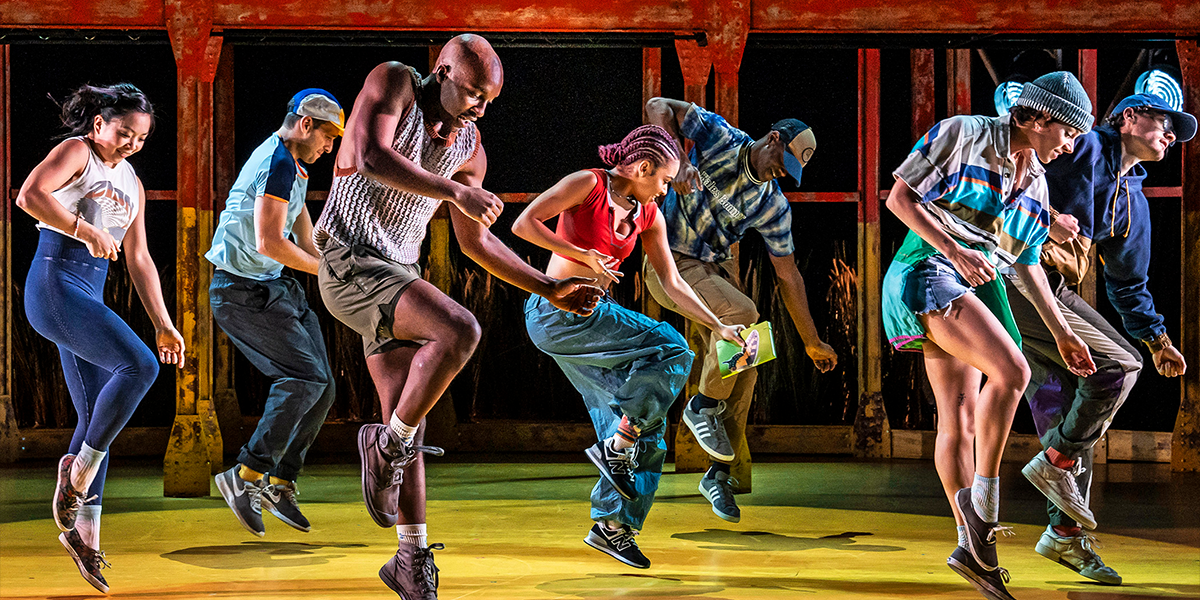'Illinoise' review — Sufjan Stevens musical has a heart as big as the title state
Read our review of Illinoise on Broadway, a dance musical adapted from the same-named album by Sufjan Stevens and directed and choreographed by Justin Peck.
Sufjan Stevens's 2005 indie rock album Illinois continues to be celebrated for its complex lyrics and lush orchestrations. It's ironic, then, that in Illinoise, the stage adaptation of the album's songs now on Broadway after an Off-Broadway premiere earlier this year, doesn't feature a single spoken word.
Three vocalists sing Stevens's lyrics atop a live band, but dance really does the talking. Tony Award-winning director/choreographer Justin Peck (Carousel) elevates the original album into a thrilling dance theatre piece that bursts with imagination and heart.
Dance theatre skeptics, be not afraid: With a little help from some props and words painted on Adam Rigg's set, you'll be able to follow what's going on and where. It helps that the first part of the show isn't meant to convey a connected plot: As they journal around a campfire in rural Illinois, various featured dancers use movement to share their individual histories.
Jeanette Delgado stands out with a spine-tingling number about being haunted by the legacy of the Founding Fathers (set to Stevens's "They Are Night Zombies!! They Are Neighbors!! They Have Come Back from the Dead!! Ahhhh!"), while "The Man of Metropolis Steals Our Hearts" features choreography that soars ever-upward like Superman, an analogy for another dancer's (Brandt Martinez as Clark) sense of hope.
Our protagonist among the crowd is Henry (Ricky Ubeda, powerful), who finds healing by telling his story. That portion of the show opens with "Decatur," a standout number featuring playful choreography depicting the friendship between Henry and Carl (a heartbreaking Ben Tyler Cook). It teeters on the line between intimate in a brotherly sense and intimate in a, well, intimate sense — but that's reserved for Carl and his love, Shelby (Gaby Diaz).
Whereas Ubeda and Cook dance like mirror images, Cook and Diaz (who are real-life partners) dance like puzzle pieces that fit perfectly into each other. Both are gorgeous and, eventually, wrenching. They add new dimensions to Stevens's music and make Illinoise unforgettable.

Illinoise summary
In an Illinois cornfield, a group of people gather around a campfire to share stories. It appears they've done so before, except Henry — he's a newcomer looking for community and connection. After various other group members tell their tales, it gives Henry the courage to share his: of his queerness and how it relates to his lost relationships with Carl and Shelby, his once-best friends.
Illinoise is based on Illinois, a 2005 indie rock album by Sufjan Stevens. The album's songs, which more or less appear in order in Illinoise on Broadway, are inspired by various people, places, and landmarks associated with the state. Peck and Pulitzer Prize-winning playwright Jackie Sibblies Drury conceived Henry's story, and the way all the songs fit into it, specifically for the show.
What to expect at Illinoise
A billboard that reads "Welcome to Illinoise," as opposed to Illinois, is our first sign (literally) that we're not in a strictly naturalistic version of the title state. Ditto for graffiti that notes our more precise location as "Small Town Middle of Nowhere." We're in a kind of liminal space between reality and storytelling, present moment and memory.
Illinoise is a jukebox musical, a dance musical, an indie rock ballet, and an adaptation of existing media. And yet it's also none of those things. Peck and Drury smartly didn't shoehorn Stevens's experimental, abstract songs into a traditional plot like most jukebox musicals. Each song scores its own vignette, and those vignettes build on each other to create Illinoise, but each could stand on its own.
The music sets the mood while the actors express their emotions through movement, which incorporates ballet and contemporary styles. Illinoise defies categorization — and that's what makes it thrilling.

What audiences are saying about Illinoise
Illinoise has an 88% audience approval score (out of 296 ratings) on Show-Score, inclusive of the Off-Broadway and Broadway runs. Many people praised the show's originality and performances.
- "Don't see it if you can't follow non-verbal narrative, or expect elaborate sets. This is proof that exceptional artistic expression only needs great talent." - Show-Score member GreatAvi
- "While prioritizing dance over musical and narrative intricacies, the show took bold risks. It's refreshing to see such innovation on Broadway. However, this focus may leave those craving depth in storytelling and musicality wanting more." - Mezzanine user J
- "imagine violently sobbing during a tap number that could never be me" - Mezzanine user eli
- "Good idea to read the insert in the program before the performance in order to gain insight as to exactly what each scenario is depicting." - Show-Score user Stephen 18
Read more audience reviews of Illinoise on Show-Score.
Who should see Illinoise
- Fans of Stevens's Illinois album, of course, are sure to enjoy hearing the songs live. Plus, one of the album's original vocalists, Shara Nova, sings live in the show.
- Ballet patrons will enjoy seeing the work of Justin Peck, a resident choreographer with New York City Ballet and a choreographer for the films Maestro and Steven Spielberg's West Side Story.
- Fans of the competition TV show So You Think You Can Dance may recognize numerous alums, including past winners Ricky Ubeda and Gaby Diaz and former contestant Rachel Lockhart.
- Those interested in queer stories will be moved by the simple yet poignant journey of Henry, who finds comfort and community again after his feelings for his childhood best friend lead only to sadness.
- Anyone who wants to see the fastest and most expressive tap dancing on Broadway will find Byron Tittle performing it during Illinoise's "Jacksonville" number.
Learn more about Illinoise on Broadway
Photo credit: Illinoise on Broadway. (Photos by Liz Lauren)
Originally published on
